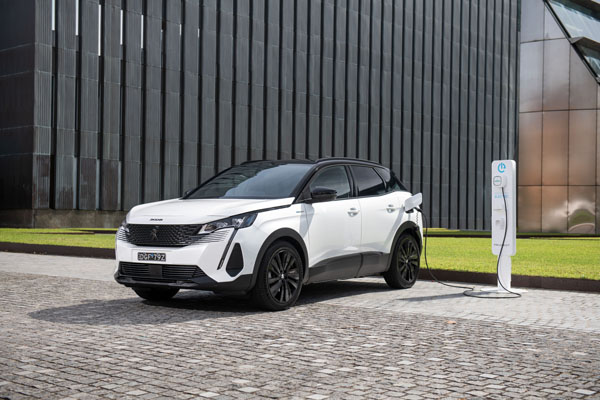
The Peugeot 300 Hybrid car looks amazing and confirms the French know a thing or two
about style. The detail in the complex front design with its dark chrome grille is exceptional
and integrates striking LED lighting unlike anything else you might have seen, especially at
night.
Inside, quilted Nappa leather seats with their contrast stitching look top shelf, but we found
them a little small and uncomfortable.
One of the hallmarks of the brand is its tiny steering wheels and high-mounted instrument
cluster, designed to replace the need for a head-up display.
The 3008 plug-in hybrid is a well-equipped car. You get partial leather and twin zone
climate air with rear seat air vents, Lime Wood dash and door trim, blue ambient cabin
lighting, heated front seats, a power-adjust driver’s seat with massage plus keyless entry
and push-button start.
The instrument panel is digital and fully customisable, a 360-degree camera, parking
sensors front and rear, semi-autonomous parking assist (90 degree and parallel), adaptive
cruise control with stop and go, automatic high beam, speed sign recognition and
recommendation and hands-free tailgate.
The plug-in hybrid comes with a mode two charging cable, supplied with the vehicle at
time of delivery. (Note the bag for the cable is an $87 accessory).
INFOTAINMENT
Infotainment consists of a 10.0-inch touchscreen, with Bluetooth, voice recognition, built-in
satellite navigation, DAB+ radio, Apple CarPlay and Android Auto smartphone mirroring.
Until recently it also came with a premium 10-speaker, 515-watt Focal sound system, but
due to supply problems this is temporarily unavailable.
There’s three 12V sockets (dashboard, rear cabin and load area), with a single USB Type
A socket for the front and another two for the back seat.
ENGINES / TRANSMISSIONS
The plug-in hybrid features a 1.6-litre turbo-petrol engine, two electric motors and a
13.2kWh battery.
The petrol engine is good for 147kW of power at 6000 rpm and 300Nm of torque at 3000
rpm.
The electric motor that drives the front wheels delivers 81kW at 2500 and 320Nm from
500-2500 rpm, while the motor for the rear axle adds another 83kW at 14,000 rpm and
166Nm from 0-4760 rpm.
Together the system pumps out a combined output of 222kW and 520Nm.
Drive is to all four wheels through an eight-speed automatic transmission which has a wet,
multi-plate clutch to manage input from the three different power sources.
SAFETY
Five-star safety includes six airbags and automatic emergency braking that detects
pedestrians and cyclists in low light conditions, and operates between 5km/h and
140km/h.
There’s also driver warning alert, active blind spot monitoring and lane keeping assistance
with detection of roadsides.
IsoFix child seat mounts are located on the outboard seats.
DRIVING
Fuel consumption, which is supposedly what it is all about, is a claimed 1.6L/100km from a
43-litre tank, and it produces 36.4 g/km of CO2.
Charging from zero per cent to full capacity takes about five and a half hours using a
2.3kW Mode 2 cable and offers 60km (WLTP) of emissions free, pure electric drive.
That’s enough we’re told to take care of the daily commute, that is if you live within 30km
of work. If you’re lucky enough to have access to a charger, it’s 60km each way.
In our week with the car, we were using 6.8L/100km after 400km which is pretty good,
even with little help from the battery.
The batteries et al add about 415kg of weight to the car, which tips the scales at 1815kg.
There are gear change paddles and four drive modes to go with the 222kW/520Nm and as
you can imagine it gets mobile.
Ride and handling is pretty good for a car that has not benefited from Australian tuning,
but this has always been Peugeot’s forte.
The small steering wheel takes some getting used to, and the gear change is a bit fiddly.
Default drive mode is electric which means it uses up the battery first.
The B transmission setting increases regenerative braking and ideally this is for use on
long downhill runs.
Otherwise, there is no regenerative adjustment.
Hybrid mode switches between the electric and petrol engines depending on your driving
style.
Sport gives you both power sources at once, while AWD as its name suggests delivers
four-wheel traction at low to medium speeds.
The battery pack which sits under the boot and back seat reduces the amount of load
space available, from 591 to 529 litres with the rear seat in place.
The MyPeugeot app provides access to the owner’s handbook online, service and
maintenance schedules, as well as fuel tank levels and odometer readings.
You can even check where you parked or plan a trip, then send that information to the car
navigation system.
SUMMING UP
The Peugeot 3008 GT Sport Plug-In Hybrid AWD certainly lifts the bar for the French car
maker. But at $80K it’s a big ask and there’s plenty of competition around the same price.
RATINGS:
Looks: 8.5/10
Performance: 8/10
Safety: 8/10
Thirst: 8/10
Practicality: 7/10
Comfort: 7/10
Tech: 8/10
Value: 7/10
Overall: 7.7/10
AT A GLANCE
MODEL RANGE
3008 Allure: $47,240
3008 GT Petrol: $50,390
3008 GT Diesel: $53,540
3008 GT Sport: $59,840
3008 GT Sport Plug-In Hybrid AWD: $79,990
Note: These prices do not include government or dealer delivery charges. Contact your
local Peugeot dealer for drive-away prices.
SPECIFICATIONS:
Peugeot 3008 GT Sport Plug-In Hybrid AWD, medium-sized five-door SUV
PERFORMANCE:
Capacity: 1.6 litres
Configuration: Plug-in hybrid, 4-cylinders in-line
Combined maximum power: 222kW
Combined maximum torque: 520Nm
Fuel Type: Petrol 95 RON
Combined Cycle (ADR 81/01): 1.6 L/100km
CO2 Emissions: 36.4 g/km
DRIVELINE:
8-sp automatic, all-wheel drive
DIMENSIONS, WEIGHT AND CAPACITIES:
Length: 4447 mm
Wheelbase: 2675 mm
Width: 2098 mm
Height: 1623 mm
Fuel Tank Capacity: 43 litres
Turning circle: 10.7 metres
Kerb Mass: 1840 kg
BRAKES:
Front: Ventilated disc brakes with sliding caliper and automatic wear adjustments
Rear: Sliding calliper disc brakes
STANDARD WARRANTY:
Five years/unlimited kilometres (battery eight years/160,000km)